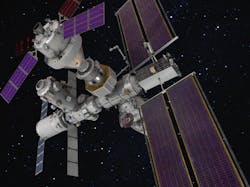Lockheed Martin, Westinghouse to develop on-orbit high-power electricity generation in future space missions
KIRTLAND AIR FORCE BASE, N.M. – U.S. Space Force experts are hiring two major contractors to develop enabling technologies for high-power space-based nuclear power generation for propulsion and power for future satellites and space stations.
Officials of the Air Force Research Laboratory at Kirtland Air Force Base, N.M., announced contracts in late September to the Lockheed Martin Corp. Space segment in Littleton, Colo., and to Westinghouse Government Services LLC in Hopkins, S.C., for the Joint Emergent Technology Supplying On-orbit Nuclear Power (JETSON) high power mission application program.
Lockheed Martin and Westinghouse Government Services will mature JETSON spacecraft systems and subsystems designs, and develop the overall space nuclear power program. Lockheed Martin won a $33.7 million contract, while Westinghouse won a $17 million contract.
This project is separate from, but related to, a $33.7 million contract awarded the same day to Intuitive Machines LLC in Houston for the Joint Emergent Technology Supplying On-orbit Nuclear Power (JETSON) Low Power System program.
Intuitive Machines will find new ways to develop compact radioisotope power systems, electric and hybrid propulsion for power conversion, power management, on-orbit mobility, thermal regulation, deployable structures, radiation shielding, and electronic hardening for future propulsion and sensor payloads aboard small satellites.
Nuclear electric power systems may provide unique advantages over conventional power systems for spacecraft, and drive enhancements to future space missions and spacecraft design, Space Force officials explain.
Space Force wants to develop nuclear electric power systems for electric propulsion and power generation that may lead to improved and new national security payloads, enable future defense missions, and switch away from traditional orbital operations that use solar arrays or other means, experts say.
Lockheed Martin and Westinghouse will focus on maturing technologies and reducing risks of developing space nuclear systems, and on developing subcomponent technologies for space fission reactors.
The effort revolves around developing a fission reactor. The companies will investigate enabling technologies in fission-based power generation; thermal management; power conversion; radiation shielding and electronic hardening; deployable structures; power management and distribution; and electric/hybrid propulsion systems.
This effort will investigate how the Space Force could use nuclear fission power systems from a subsystem, spacecraft, and enterprise architecture standpoint for a high-power system that involves a communications satellite in or near low lunar orbit and the future NASA Gateway lunar space station. The flight demonstration system should be designed to operate for one year of mission operations and two years of extended mission operations.
The fission power system must be able to produce 6 kilowatts maximum and 4 kilowatts minimum; or 20 kilowatts maximum and 15 kilowatts minimum depending on power conversion redundancy.
Related: DARPA and NASA select Lockheed Martin to develop nuclear-powered spacecraft
This space nuclear power system must activate on-orbit; demonstrate on-orbit mobility via a propulsion system; demonstrate thermal management during continuous operational power; indicate how thermal system designs may change during routine cycling of electric power to the payload and electric propulsion subsystems.
The system also will provide fault-recovery management for power conversion system during non-steady-state thermal conditions; and provide radiation shielding, and will design-in cyber security and DevSecOps information security from the outset.
On these contracts, Lockheed Martin and Westinghouse will do the work in Denver, and in Hopkins, S.C., and should be finished by December 2025. For more information contact Lockheed Martin Space online at www.lockheedmartin.com/en-us/capabilities/space.html, or Westinghouse Government Services at www.westinghousenuclear.com/government.
About the Author
John Keller
Editor-in-Chief
John Keller is the Editor-in-Chief, Military & Aerospace Electronics Magazine--provides extensive coverage and analysis of enabling electronics and optoelectronic technologies in military, space and commercial aviation applications. John has been a member of the Military & Aerospace Electronics staff since 1989 and chief editor since 1995.
